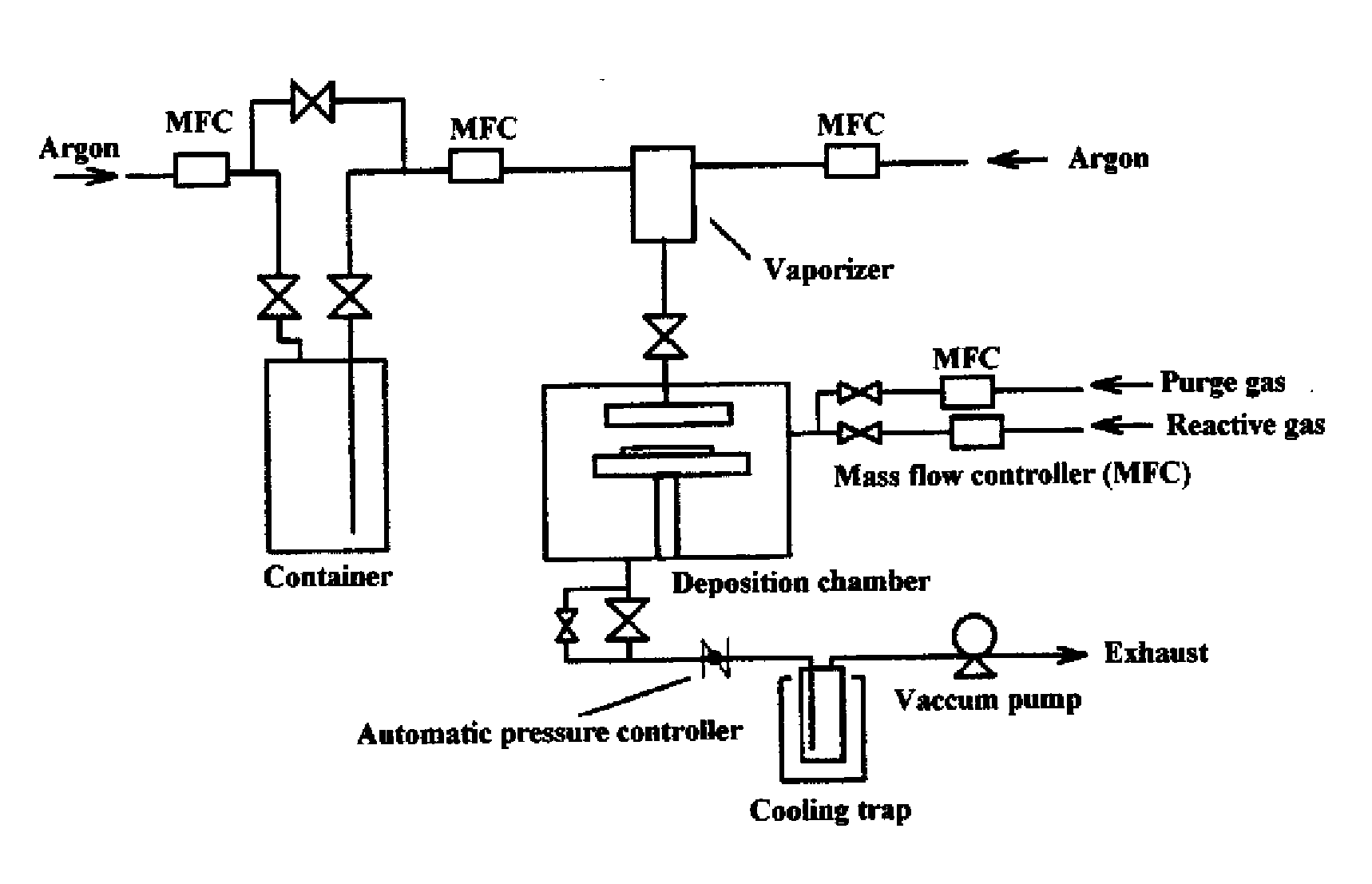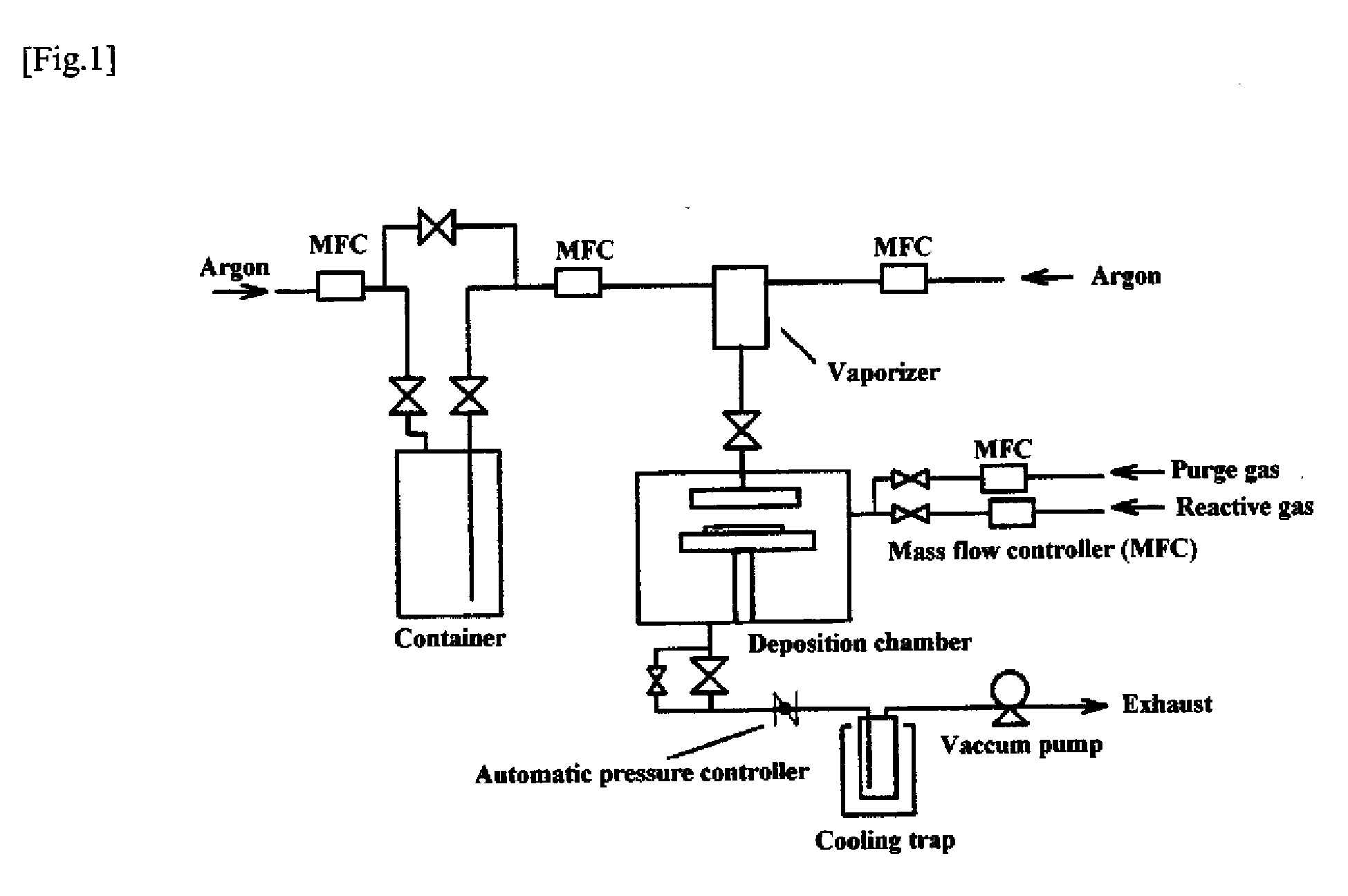Metal compound, material for chemical vapor phase growth, and process for forming metal-containing thin film
a technology of metal compound and chemical vapor phase, which is applied in the direction of organic chemistry, coatings, liquid/solution decomposition chemical coatings, etc., can solve the problems of poor thermal stability, difficult for the resulting film to exhibit electrical characteristics, and high temperature unsuitable for semiconductor device elements such as gate films, etc., to achieve stable film composition control, reduce residual carbon, and reduce the effect of residual carbon
- Summary
- Abstract
- Description
- Claims
- Application Information
AI Technical Summary
Benefits of technology
Problems solved by technology
Method used
Image
Examples
example 1
Preparation of Compound No. 2
[0045]A reaction flask was charged with 43.0 g of titanium tetrachloride (TiCl4) and 500 ml of dehydrated hexane and cooled to −10° C. in a dry argon atmosphere. A mixed solution of 191 g of tetrakis(ethylmethylamino)titanium (Ti[N(CH3)(C2H5)]4) and 500 ml of dehydrated hexane was added thereto dropwise in a manner such that the reaction system temperature might not exceed −5° C. Completion of the dropwise addition was followed by stirring at room temperature for 8 hours. Hexane was removed by evaporation under reduced pressure, and the residue was distilled under reduced pressure. From a fraction collected at a distillation temperature of 82° C. under a pressure of 100 Pa was obtained compound No. 2 in a yield of 90%. Identification of the compound was accomplished by elemental analysis and 1H-NMR analysis. The results of the analyses are shown below.
[0046](1) Elemental analysis (metal analysis via atomic absorption / chloride analysis via silver nitrate ...
example 2
Preparation of compound No. 6
[0051]A reaction flask was charged with 55.7 g of titanium tetrachloride (TiCl4) and 300 ml of dehydrated toluene and cooled to −10° C. in a dry argon atmosphere. A mixed solution of 82.3 g of tetrakis(ethylmethylamino)titanium (Ti[N(CH3)(C2H5)]4) and 300 ml of dehydrated toluene was added thereto dropwise in a manner such that the reaction system temperature might not exceed −5° C. Completion of the dropwise addition was followed by stirring at room temperature for 8 hours. Toluene was removed by evaporation under reduced pressure, and the residue was distilled under reduced pressure. From a fraction collected at a distillation temperature of 85° C. under a pressure of 100 Pa was obtained compound No. 6 in a yield of 90%. Identification of the compound was accomplished by elemental analysis and 1H-NMR analysis. The results of the analyses are shown below.
[0052](1) Elemental analysis (metal analysis via atomic absorption / chloride analysis via silver nitr...
example 3
Fabrication of Titanium Nitride Thin Film
[0060]A titanium nitride thin film was fabricated on a silicon wafer by ALD using the equipment illustrated in FIG. 1 and compound No. 2 obtained in Example 1 as a chemical vapor phase growth material under the conditions described below. The resulting film was analyzed by X-ray fluorometry to determine the film thickness and composition. It was found as a result that the film thickness was 60 nm, the film composition was titanium nitride, and the carbon content was 1.3 at %.
ALD Conditions:
[0061]Reaction temperature (substrate temperature): 300° C.
Reactive gas: NH3
[0062]Three hundred cycles each having steps (1) to (4) were performed.
(1) A CVD material vaporized in the vaporizer at 120° C. and 250 Pa was pulsed into the deposition chamber and allowed to deposit for 3 seconds under a system pressure of 250 Pa.
(2) The chamber was purged with argon for 3 seconds to remove the unreacted material.
(3) The reactive gas was pulsed into the chamber a...
PUM
| Property | Measurement | Unit |
|---|---|---|
| temperature | aaaaa | aaaaa |
| melting point | aaaaa | aaaaa |
| pressure | aaaaa | aaaaa |
Abstract
Description
Claims
Application Information
 Login to View More
Login to View More - R&D
- Intellectual Property
- Life Sciences
- Materials
- Tech Scout
- Unparalleled Data Quality
- Higher Quality Content
- 60% Fewer Hallucinations
Browse by: Latest US Patents, China's latest patents, Technical Efficacy Thesaurus, Application Domain, Technology Topic, Popular Technical Reports.
© 2025 PatSnap. All rights reserved.Legal|Privacy policy|Modern Slavery Act Transparency Statement|Sitemap|About US| Contact US: help@patsnap.com



